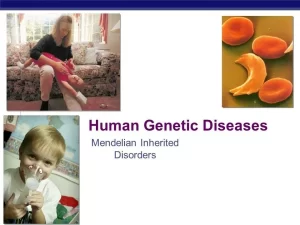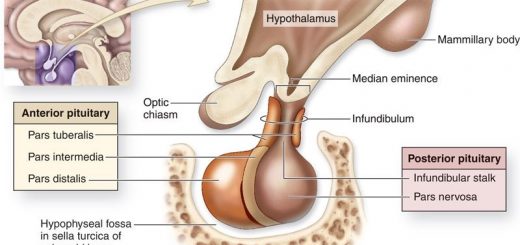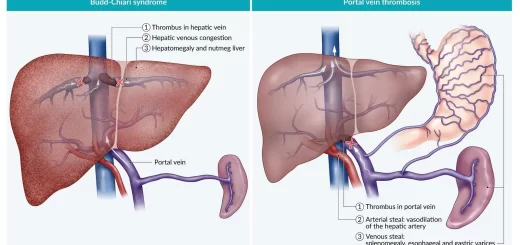Learning Objectives of basic medical genetics, Impact and Types of Genetic Diseases
As a result of the vast improvement in medicine during the 20th century, the pattern of disease has changed with the result of increasing recognition of the role of genetic factors in causing illness at all ages. Following the completion of the human genome project and the advancement of biotechnology techniques and the complete sequencing of the human genome, it became possible to correlate the phenotype of an individual (disease or trait) to the genotype.
Impact of Genetic Diseases
The incidence of genetic disorders in different age groups is based on the following observations:
- Spontaneous miscarriages: chromosomal abnormalities account for about 50% of all first-trimester pregnancy losses; 1 in 6 of pregnancies end in spontaneous miscarriages.
- Neonatal period: 2-3% of live births have major congenital abnormalities at least 50% of these are exclusively or partially genetic in origin. The incidence of single gene disorders is 1:100, and that of chromosomal disorders is 1:200.
- Childhood period: 50% of childhood deafness, blindness and learning difficulties are of a genetic cause. In developed countries, genetic disorders and congenital malformations account for about 30% of childhood hospital admission. Adulthood: Common adulthood illnesses cardiovascular disease, Diabetes, schizophrenia, manic depressive disorders and Alzheimer’s disease have a strong genetic contributing component.
- Cancer is considered a genetic disease at the tumour cell level; 5-10% of common cancers (breast and colon) have a strong hereditary component.
Types of Genetic Diseases
- Single Gene Disorders: following Mendelian or non-Mendelian inheritance.
- Multifactorial/Polygenic Disorders.
- Chromosomal Disorders.
- Mitochondrial Disorders.
- Somatic Cell Genetic Disorders: this genetic disorder in contrast to the above types is not transmitted to subsequent generations since the defect is localised to somatic cells. The paradigm of these diseases is sporadic CANCER.
What is a pedigree
A pedigree is a chart representation of an individual ancestry and relatedness of family members.
Pedigree Construction-Why take a family history?
- To determine the segregation of a particular trait or disorder, and hence determine its genetic background. We rely on observing the way in which the trait is transmitted from one generation to another and/ or studying its frequency among relatives. This is achieved through detailed family history and pedigree construction. Taking accurate family history in itself can provide a diagnosis. This should be undertaken by the family doctor and the general practitioner to determine any possible genetic background of the presenting illness of an individual, called in this case the proband or index of a pedigree.
- To determine the mode of inheritance of a trait or disorder.
- To allow accurate risk calculation for other relatives in a family i.e. the likelihood of their developing it or passing it to their children.
- To provide proper genetic counselling to patients and family members.
the Proband/index is the family member who brings the family to clinical attention and is highlighted in the pedigree by being symbolised by an arrow.
Consultand: An unaffected person seeking genetic counselling and is highlighted in the pedigree by being symbolised by an arrow.
Pedigrees with generations and individuals are numbered according to their order of birth within a generation. Different generations are numbered with Roman numbers.
Learning Objectives of Basic Medical Genetics
Outline the components of central dogma and their effect on phenotype (trait/disease). Recognize the clinical impact of genetic diseases. Classify the types of genetic disorders. Identify the different symbols of a pedigree (family tree). Construct a pedigree based on family history taking. Distinguish types of cell division and related abnormal chromosomal segregation.
Classify the types of numerical chromosomal disorders. Differentiate aneuploidies and polyploidies. Determine mechanisms involved in chromosomal structural abnormalities. Differentiate balanced and unbalanced karyotypes. Discuss common examples of chromosomal abnormalities. Recognize the mechanism involved in the etiology of some clinical chromosomal disorders.
Determine the recurrence risk of different types of Down Syndrome. Outline methods of Chromosomal analysis. Define karyotype and ideogram. Describe a normal karyotype. Interpret and describe abnormal karyotypes. List indications for chromosomal analysis for patient and family members.
Define terms commonly used in basic and clinical practice of medical genetics. Determine patterns of Mendelian inheritance. Recognize pedigrees suggesting different modes of inheritance. Mention examples of genetic disorders of the different modes of inheritance. Discuss types of non-classical Mendelian inheritance.
Identify patterns and characteristics non-Mendelian inheritance, including mitochondrial inheritance, genomic imprinting and disorders resulting from dynamic mutation. Recognize the characteristics of polygenic disorders and common clinical examples. Mention clinical examples for different modes of inheritance.
Classify causes of genetic variants and its effect. Determine the effect of genetic variation. Define the characteristics of a polymorphic variant. Describe the criteria of a pathogenic variant. Identify the method of variant analysis. Differentiate different methods used in molecular diagnosis.
Describe the genes involved in tumourigenesis. Identify mechanisms of oncogene and tumour suppressor gene mutation in the process of tumorigenesis. Discuss the pathogenesis of carcinogenesis at the genotype and phenotype level. Realize the multistep process of tumourigenesis. Discuss some familial cancer disorders.
Compare and contrast traditional and precision medicine. Differentiate terms of pharmacogenetics, pharmacogenomics and personalized medicine. Define xenobiotic genes and their role in drug metabolism. Identify the principal of tailoring therapy. Mention examples of personalized medicine based on genotyping in current practice.
You can follow science online on YouTube from this link: Science online
You can download Science Online application on Google Play from this link: Science online Apps on Google Play
Vaccines types, Live vaccines, Inactivated vaccines, Subunit vaccines, Naked DNA & mRNA vaccines
Cytokines function, use, definition, inflammation & side effects




